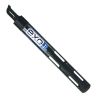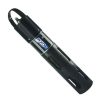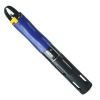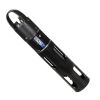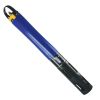YSI EXO Optical Dissolved Oxygen Sensor
Features
- 0 to 50 mg/L measurement range
- T63<5 sec response time
- ±0.1 mg/L or 1% of reading accuracy from 0 to 20 mg/L
- Free ground shipping
- Expedited repair and warranty service
- Lifetime technical support
- More
The EXO optical dissolved oxygen sensor is a digital smart sensor featuring welded titanium construction and wet-mateable connectors. For long-term, in situ continuous monitoring of dissolved oxygen, the EXO2 and EXO3 sondes have a wiper to clean the dissolved oxygen sensor to avoid sensor fouling and maintain accuracy.
The principle of operation of the EXO optical dissolved oxygen sensor is based on the well-documented concept that dissolved oxygen quenches both the intensity and the lifetime of the luminescence associated with a carefully chosen chemical dye. The EXO DO sensor operates by shining a blue light of the proper wavelength on this luminescent dye which is immobilized in a matrix and formed into a disk. The blue light causes the immobilized dye to luminesce and the lifetime of this dye luminescence is measured via a photodiode in the probe. To increase the accuracy and stability of the technique, the dye is also irradiated with red light during part of the measurement cycle to act as a reference in the determination of the luminescence lifetime.
When there is no oxygen present, the lifetime of the signal is maximal; as oxygen is introduced to the membrane surface of the sensor, the lifetime becomes shorter. Thus, the lifetime of the luminescence is inversely proportional to the amount of oxygen present and the relationship between the oxygen pressure outside the sensor and the lifetime can be quantified by the Stern-Volmer equation: ((Tzero/T) – 1) versus O2 pressure. For most lifetime-based optical DO sensors, this Stern-Volmer relationship is not strictly linear (particularly at higher oxygen pressures) and the data must be processed using analysis by polynomial non-linear regression. Fortunately, the non-linearity does not change significantly with time so that, as long as each sensor is characterized with regard to its response to changing oxygen pressure, the curvature in the relationship does not affect the ability of the sensor to accurately measure oxygen for an extended period of time.
In The News
From the Tap: Source Water Monitoring for Public Health
In regions with historically secure access to clean drinking water, few think about the work that goes into ensuring that the water they fill their cups with is safe. In reality, millions of dollars are invested in the infrastructure, equipment and teams involved in converting source water into drinking water. While all the work that goes into providing clean water often goes unnoticed, analysts like Michele Gilkerson, a water research analyst with the City of Columbus Division of Water, know exactly how much goes into securing safe water for millions of people. Gilkerson started with Battelle Memorial Institute in 1991 in their water ecology section. There, she saw how interesting source water monitoring could be, even though it isn’t often spotlighted in the environmental sector.
Read MoreYSI EXO3s: The Latest in Water Quality Monitoring
The YSI EXO3s offers the latest in multi-parameter water quality monitoring equipment that has a comprehensive list of smart sensors. With an external power source, this sonde is a cost-effective, compact EXO that has the same capabilities as the EXO3 . The sonde is built to last with resilient materials and backed with vigorous testing. The device has five ports for available YSI EXO smart sensors or central wiper. It seamlessly integrates with a data logger to collect and push valuable data to the cloud for access from a PC or mobile device. This small sonde is exceptional for both sampling and continuous monitoring applications.
Read MoreTotal algae sensor is the newest addition to YSI's EXO sondes
Many algae sensors can detect Chlorophyll a or levels of blue-green algae. YSI’s new Total Algae Sensor can measure both at the same time. “If you’re only looking at Chlorophyll a, you can miss a very big portion of total algae biomass,” said Tim Finegan, product manager. The new sensor is an optional attachment to the company’s line of EXO sondes, which debuted earlier this year. It’s an optical probe and maintenance is limited to keeping the sapphire windows on the unit clean. The Total Algae Sensor can be calibrated in two different ways, one for spot sampling and one for continuous sampling, which allows users to make sure readings are accurate for their specific monitoring applications.
Read More





